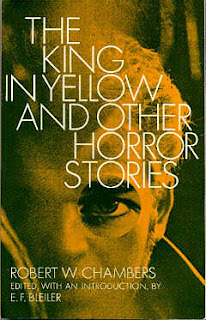If Robert William Chambers is known at all, he’s known to Lovecraft aficionados.
Chambers, born in 1865 to a wealthy Brooklyn family, set out to be a painter, studying in Paris from 1886 to 1893. He soon turned to writing; his first novel, a romance set in the Latin Quarter of Paris, was published in 1894. However, the 1895 collection The King in Yellow contained the weird stories that Lovecraft enjoyed.
Many of the stories in The King in Yellow involve, sometimes in a minor way, a mysterious play of the same name; those who read it are driven mad by “words in which the essence of purest poison lurk(s).” The play is linked to the Yellow Sign, “a curious symbol or letter... It was neither Arabic nor Chinese, nor… did it belong to any human script”. In reference to the play, Chambers uses names from several stories in Ambrose Bierce’s 1893 collection Can Such Things Be? While there are some fairly mundane stories in The King in Yellow, the supernatural ones are written with delicacy and pervaded by a gloomy melancholy; doomed love, suicide, and insanity are common themes. They are all told in the first person, usually by a young and sensitive artist.
involve, sometimes in a minor way, a mysterious play of the same name; those who read it are driven mad by “words in which the essence of purest poison lurk(s).” The play is linked to the Yellow Sign, “a curious symbol or letter... It was neither Arabic nor Chinese, nor… did it belong to any human script”. In reference to the play, Chambers uses names from several stories in Ambrose Bierce’s 1893 collection Can Such Things Be? While there are some fairly mundane stories in The King in Yellow, the supernatural ones are written with delicacy and pervaded by a gloomy melancholy; doomed love, suicide, and insanity are common themes. They are all told in the first person, usually by a young and sensitive artist.
“The Yellow Sign” involves a resurrected corpse, a repetitive question ("Have you found the Yellow Sign?"), and doomed love.
“The Repairer of Reputations” lacks a supernatural element, but contains a paranoid narrator and the title character, Mr. Wilde, who has savage battles with his cat:
“Howling and foaming, they rolled over and over on the floor, scratching and clawing, until the cat screamed and fled under the cabinet, and Mr. Wilde turned over on his back, his limbs contracting and curling up like the legs of a dying spider. He was eccentric.”
Other noteworthy stories in the collection include the delicate love triangle of “The Mask”, the grim “In the Court of the Dragon”, and the sad prose poem “The Street of the Four Winds”.
Eventually, Chambers became a popular author, publishing over 70 historical and romantic novels before his 1933 death. By all accounts, they haven’t stood the test of time, and the only one I’ve read (Who Goes There!, 1915), certainly hasn’t. He revisited supernatural themes only a few times.
Still, Chambers’ early works impressed Lovecraft. In “Supernatural Horror in Literature” (1927), Lovecraft praises Chambers: “The King in Yellow really achieves notable heights of cosmic fear in spite of uneven interest and a somewhat trivial and affected cultivation of the Gallic studio atmosphere…” Chambers’ influence is most apparent in “The Whisperer in Darkness” (1931), which includes direct references to things Carcosan. Then there are the Deep Ones. Chambers wrote a series of humorous, or purportedly humorous, stories about a Bronx zookeeper and his cryptozoological expeditions. In one of the stories, “The Harbor-Master”, the zookeeper comes across a sinister gilled humanoid lurking in New England waters. It also seems likely that Lovecraft’s penchant for vague supernatural name-dropping and forbidden books that drive men mad may owe a debt to Chambers.
So, although Chambers made his living off his popular novels, his early weird tales, imaginative, melancholy, and idiosyncratic, are all that he’s remembered for.




No comments:
Post a Comment